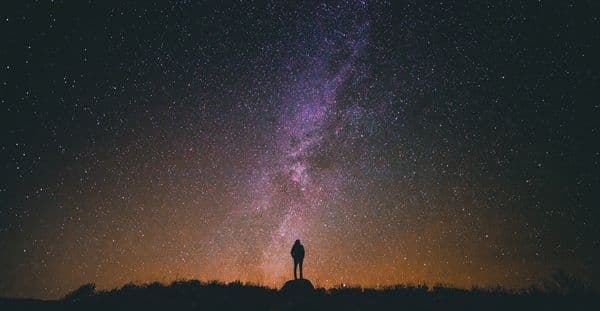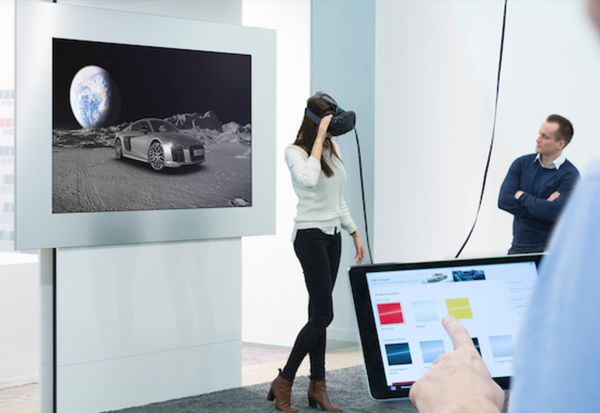Virtual Reality and Next-Gen Experiences
Remember Star Trek’s holodeck and how amazing you thought it would be to have something like it? You could just walk into a room and immediately be at a beach having a mojito. It’d be so realistic, you’d actually have to apply sunscreen to keep from getting sunburned.

Forty years have passed since the holodeck first appeared in Star Trek and we are entering an age where technology is providing us with equally imaginative ways of experiencing products and services.
 A screenshot from Star Trek: The Next Generation. William Riker entering holodeck.
A screenshot from Star Trek: The Next Generation. William Riker entering holodeck.
Despite the rapid technological development, we are only now starting to realize what sort of crazy things we can make with it. Certainly our imagination was never the limit. Just think of George Orwell’s 1984, published in 1949, with all those two-way monitors, or the holodeck forty years ago. Virtual reality was first developed around the same time and there have been a few waves of VR hype during the past decades, but the technology has lacked that something to make a big splash.
Today, technology is an enabler for creating services that improve our lives. John Maeda recently stated in a KPCB blog post that technology is no longer valuable without design. There’s a marked drift towards improved user experiences as technology keeps on advancing and becoming more powerful. What we are seeing now is a move away from an ‘imagining mode’ to a collaborative ‘doing mode’. Designers and developers are finally finding ways to collaborate in a meaningful way using available technologies.
Destination: A new way of seeing
Writer Marcel Proust wrote: “My destination is no longer a place, rather a new way of seeing.”
We already have friends we talk to on a daily basis even though they are on the other side of the world. They are real friends, virtually. We have meetings and negotiations happening face-to-face. They happen virtually, but you still feel like the person is in the same room with you. We can have sexual experiences that happen inside of a headset device, accompanied by a physical experience: a twerking butt.
It might sound funny, but it’s an innovative start for the mass adoption of immersive experiences that blur the line between real life and virtual reality. “Virtual reality will have an impact on every aspect of life, from entertainment to education and relationships,” says Michael Acton Smith in easyJet’s Traveller magazine’s article on future scenarios (Nov 2015).
If you’ve seen Spike Jonze’s movie “Her” (2013), your imagination might be running wild after reading about a twerking butt and how virtual reality will have an impact on relationships!
 A highlight from PornHub's Twerking Butt demo video
A highlight from PornHub's Twerking Butt demo video
In his piece for easyJet’s Traveller, Smith envisions what happens in 2035. By that time, surely most or all our service experiences will be immersive in one way or another.
Today, however, we are used to imagining things in constrained environments; 2D spaces, applications and small screens. Experience immersion has only just started becoming a reality in a number of industries, but there’s nothing radically immersive out there yet.
The game industry has been a forerunner in using VR, but immersion is now making headway in other industries like retail, too. Technologies like beacons, touch screens and wearables are used to create a seamless experiences for customers. Making products easier to locate is just one (and the most obvious) way to improve the customer experience.
Burberry, with its brick-and-mortar store, and Disney, with its MagicBand, are both on top of their game. They provide customers with experiences that make the surrounding environment feel like it’s full of magic. The service experience is effortless and intuitive. Nevertheless, we are still far from a vision where virtual reality has an impact on relationships.
Or are we?
From dreams to enhancing reality
“Virtual reality at its best shouldn’t replace real life, just modify it, giving us access to so much just out of reach physically, economically. If you can dream it, VR can make it.” (Source: The Verge) We shouldn't try to replace life as we know it. Virtual reality is not for creating a life similar to Matrix. It is not for creating a generation of VR junkies, like this short film by Federico Heller suggests.
The possibilities virtual reality brings by enhancing the reality, are huge.
Let’s say we were designing a B2C service for a client in the real-estate sector and the point was helping people find vacation homes abroad. Virtual reality couldn’t replace the real life experience of touring a potential vacation home, but it could help people to find the ones they’d actually like to go see in person by providing an accurate image of the estate and size of the home. The whole point of the service is to make the process easier and economically more efficient for the customers.
Virtual reality as a technology isn’t just a “dream factor” - it can really change the way we experience things.
Just think of the medical industry or education. What if doctors and psychologists help people using virtual or augmented reality?
 Correcting the "lazy eye" with VR. Source: James Blaha YouTube
Correcting the "lazy eye" with VR. Source: James Blaha YouTube
James Blaha is a startup founder who suffers from “lazy eye” syndrome. He used Oculus RIft technology to develop a solution that improves his vision. His company, Vivid Vision, helps consumers and doctors correct people’s vision so they can see accurately with both eyes. What other types of medical problems could we could potentially solve using virtual reality?
The education industry, too, could benefit from virtual and augmented reality (including technologies like Microsoft’s HoloLens).
Understanding the dimensions and distances in astronomy and geometry would be easier for students. Or how about studying geography with the help of virtual reality? Imagine taking a walk at the Colosseum without leaving the classroom. Or taking a look inside of Mount Vesuvius while the teacher explains the tragic history of Pompeii.
Chuckle all you want, but it’s happening now
Holodeck, gesture based interfaces, digital and reality immersion... We are not that far from the science fiction seen on television and in movies.
VR expert and creator of VR industry letter CyberEdge Ben Delaney said, “People imagine VR as a technologically manifested dream world and want to do everything they can do in their dreams. I’ve been really, really getting a chuckle out of reading the hype about the Oculus, because it just feels like they’re recycling the same old press releases and nonsense that people were talking about 20 years ago.”
This year, the lines between the physical and digital will truly start to blur. The “nonsense talk” will still be there, but there are already signs of more meaningful concepts and ideas in virtual reality development.
 Audi's virtual reality showroom. Photo source: Road to VR
Audi's virtual reality showroom. Photo source: Road to VR
Companies like Audi are investing in using virtual reality to create a better car shopping experience. If an Audi showroom doesn’t have the exact car model their customer is looking for, they can still have a look at the car with different color and feature options - as a virtual reality experience. It makes the decision-making and purchase process more convenient and realistic.
The shift towards creating better user experiences is changing how virtual reality develops and what it can be used for. Sexual fantasies and more immersive game experiences will still be a big part of virtual reality development, but we have finally realised how the experience immersion can be exploited in other industries, too.
 Artist Jim Stoten's view on virtual reality. Source: The Verge
Artist Jim Stoten's view on virtual reality. Source: The Verge
Design will be set free
The current generation of experiences has already taken a leap towards digital and physical immersion with connected devices and multi-channel experiences. There has, however, been a clear separation between the “digital” and the “physical”. At Disney World, the wristbands provide a more seamless experience at the actual resort, but the customers still need to fill in a fair amount of information for the service to work up to its full potential. And the magic fades as soon as you leave the resort.
The next generation of experiences will blur the lines between digital and physical. Digital technology and the physical environment will begin to merge even more, creating new ways of using products and services as well as a new way of experiencing things. Designers and developers have found a way to work together seamlessly. This results in having a deeper understanding of user needs and technical opportunities to create meaningful products and services to improve people's daily life.
In 2016, destination is no longer a place, but rather a new way of seeing.
This is the year of next generation experiences.
I want to thank Andre Medeiros and Oskar Enhström for their help with this blog post.
- Aino HanttuService Design Lead

